Having introduced its K8 processors to high-performance computer systems first, AMD is now steadily transferring its entire infrastructure to the new advanced architecture. The Socket A platform will have become obsolete very soon – the production of processors for this older socket is expected to stop in the next few months. What’s the replacement? It’s obvious – AMD’s line-up of low-end CPUs will only include inexpensive Sempron processors for the Socket 754 platform.
Coming to be a new Duron series,AMD’s Sempron family was announced in the third quarter of the last year. Until recently almost the whole family had consisted of Socket A processors previously selling under the Athlon XP brand. There had been only one Sempron for Socket 754 systems – the top model of the series with the rating of 3100+. This model had won universal recognition from the users due to the upgrade opportunities it had given: without changing the platform, this CPU can be anytime replaced with a high-performance Athlon 64 processor with a rating up to 3700+. Upgradeability is a definite plus of any platform.
Then AMD made a second step in this plan of unification its product line-up. Prior to abandoning Semprons for Socket A altogether, AMD offered a wider selection of Semprons for Socket 754. So, February 14, the company announced new Semprons with ratings 2600+, 2800+ and 3000+, designed for Socket 754. These processors are even a little cheaper than their Socket A counterparts with the same ratings, which is an indication of AMD’s serious intention to dismiss the out-dated Sempron for Socket A as soon as possible. Eventually, there will only remain two platforms from AMD: Socket 754 for low-end and midrange systems and Socket 939 for high-performance computers and for PC enthusiasts.
We thought the release of the new Semprons for Socket 754 an intriguing event, worthy of a dedicated article, especially considering the fact that the new Semprons for Socket 754 differ somewhat from their earlier-released mate, the Sempron 3100+ model. So we just went to a nearby shop and bought a 2600+ CPU, the junior model of the Sempron for Socket 754 series, and wrote this review.
What’s Semprons?
The main distinguishing trait of the new Semprons for Socket 754 is that they are all based on the new core, called Palermo. The Palermo is a derivative from the Winchester core, with a reduced L2 cache and disabled AMD64 technology. That is, the new Sempron 2600+, 2800+ and 3000+ for Socket 754 are manufactured with 90nm tech process, but are based on the stepping D0 core, so they don’t yet support the SSE3 instruction set.
The Sempron 3100+ model, which has been marketed for long already, is also being transferred to the Palermo core, but the older, 130nm samples are still more common in shops.
Quite reasonably AMD didn’t reduce the frequency of the new Sempron 2600+, 2800+ and 3000+ too much, which would have made them perform slower than the Sempron for Socket A of the same ratings. So they dropped the performance not only by reducing the clock rate, but also by truncating the L2 cache. That is, some of the new Sempron models have a smaller L2 cache (128KB, to be exact) than the Sempron 3100+ has (i.e. 256KB).
The following table lists the characteristics of the old and new Sempron processors for Socket 754. All processors of that type available today are listed:
|
OPN |
Rating |
Core Frequency |
|
Core Voltage |
Max. Case Temperature |
L2 cache size |
Max. TDP |
|
SDA2600AIO2BA |
2600+ |
1.6GHz |
1.4V |
69 oC |
128KB |
62W |
|
SDA2800AIO3BA |
2800+ |
1.6GHz |
69 oC |
256KB |
|
SDA3000AIO2BA |
3000+ |
1.8GHz |
69 oC |
128KB |
|
SDA3100AIO3BA |
3100+ |
1.8GHz |
69 oC |
256KB |
|
SDA3100AIP3AX |
3100+ |
1.8GHz |
70 oC |
256KB |
Thus, Sempron processors for Socket 754 work at lower frequencies and have less L2 cache memory than the more expensive Athlon 64 models. The Semprons don’t also support the 64-bit extensions, but do support the NX bit.
AMD Sempron 2600+ for Socket 754 in Detail
The new Socket 754 AMD Sempron 2600+ processor is the cheapest embodiment of K8 architecture at the moment. No wonder then that its clock rate is only 1.6GHz and the amount of its L2 cache memory is just 128 kilobytes. But the processor is very affordable, being officially priced at only $78.
The new Sempron looks like just any other Socket 754 CPU:

And here’s the package the Sempron 2600+ comes to retail shops in:

The stock cooler enclosed with the Sempron 2600+ for Socket 754 doesn’t boast any extraordinary qualities. It is an all-aluminum device:

The CPU-Z utility we usually check out the characteristics of a tested CPU with doesn’t yet know anything about the new Sempron and identifies the core codename wrongly.
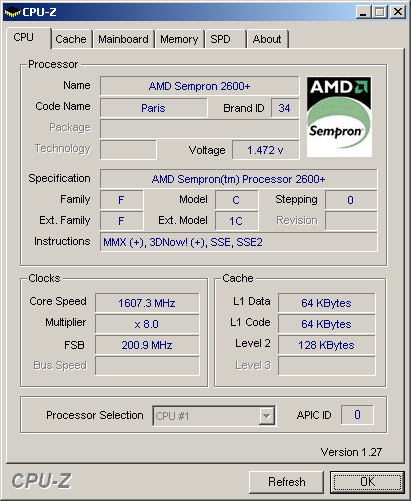
But the information about the cache memory structure is correct:

You may see that AMD reduced the cache memory by disabling some cache lines in the associativity sets, keeping the total number of the sets intact. That is, the cache of the Sempron 2600+ is 16-way set-associative, just the 1MB L2 cache of elder Athlon 64 FX models.
Besides AMD64 technology, Cool’n’Quiet is also disabled in the Sempron 2600+. As a consequence, the processor doesn’t permit to reduce its frequency multiplier. We can’t call that a serious disadvantage, though, since the Sempron 2600+ isn’t a hot chip thanks to the 90nm tech process, small L2 cache, reduced core voltage and low clock rate. We used the stock cooler in our tests of the Sempron 2600+ and the temperature of this processor never exceeded 45°C.
Influence of L2 Cache on Performance
Before comparing the performance of the new AMD Sempron 2600+ to other CPUs, we wanted to check out the influence of the size of the L2 cache on the performance of the system with a K8 processor. When testing CPUs on ClawHammer and NewCastle cores earlier, we had noted that the reduction of the L2 cache from 1 megabyte to 512 kilobytes had had a very slight impact on the performance. There are several reasons for that.
First, all K8 processors have an exclusive cache. It means that data stored in the L1 cache are not duplicated in the L2 cache. Thus, the total effective capacity of the cache memory is the sum of L1 and L2 caches. Second, the L1 cache of K8 processors is rather large by itself, 128 kilobytes. Third, each K8 CPU has an integrated memory controller, which helps to reduce the memory access latencies in comparison to processors that communicate with the memory via the chipset. That’s why the reduction of the L2 cache doesn’t affect the performance of K8 processors as dramatically as, for example, it does with CPUs of NetBurst architecture (but to be frank, when scrutinizing the new CPUs of the Pentium 4 6xx family, we noticed that the doubling of the L2 cache brought just a minor performance gain to them).
By the way, the influence of the size of the cache may become stronger in 64-bit modes as the length of data and addresses as well as of instructions is going to grow up. So, the load on the cache memory is evidently going to be higher in 64-bit applications.
But the Semprons don’t support 64-bit extensions and thus should be more tolerant to a reduction of the L2 cache. To check this out in practice we decided to compare several Socket 754 processors clocked at the same frequency, but equipped with different amounts of L2 cache memory. This test will tell us what risks AMD is running by having further reduced the L2 cache in its new Socket 754 processors, namely in Sempron 2600+ and Sempron 3000+ models.
For this test we took a Sempron 2600+ (128KB L2 cache), a Sempron 3100+ (256KB L2 cache), an Athlon 64 3000+ (512KB L2 cache), and an Athlon 64 3400+ (1024KB L2 cache) and set the clock rate of each processor to 1.6GHz. The CPUs were tested on the following testbed:
- DFI LANPARTY UT nF3 250Gb mainboard (Socket 754, NVIDIA nForce3 250Gb);
- 2x512MB Corsair CMX512-3200XLPRO DDR400 SDRAM (with 2-2-2-10 timings);
- PowerColor RADEON X800 XT graphics card (AGP 8x, 500MHz/500MHz);
- Western Digital Raptor WD740GD hard disk drive (Serial ATA-150).
We performed our tests in Windows XP with Service Pack 2.
3dmark 2001 benchmark
3DMark2001 SE yields very curious results. As you see, a perceptible performance gain occurs when the size of the L2 cache grows from 512 to 1024 kilobytes. As a result, while there’s a one-percent-or-less difference between 128KB and 256KB of cache, the gap between 128KB and 1MB of cache is more than 11%.

3dmark 2005 benchmark

Far cry Benchmark

Doom Benchmark

Gaming applications seem to be the most sensitive to the size of the L2 cache. The performance gap between processors with 128KB and 1024KB of cache can be as wide as 21% (in Doom 3). In average, the Sempron with a 128KB L2 cache is about 12-13% slower than the Athlon 64 with a 1MB L2 cache in games, if they are clocked at the same frequency.
the processor with 128KB of cache memory was based on the 90nm stepping D0 core, while the rest of the participating CPUs were based on 130nm CG stepping cores. The D0 core features an improved integrated memory controller which sometimes provides certain performance gains.
Winrar Benchmark

Data compression is a task which is among the most sensitive to the size of the L2 cache. As you can see, this size matters much in WinRAR.
encoding Benchmark

The size of the L2 cache becomes almost unimportant at all in media encoding tasks. The processor with the maximum amount of L2 cache memory is just 1-2% faster than the Sempron with a 128KB L2 cache.

The Athlon 64 with the biggest cache performs the final rendering in 3ds max 7 faster, but only by 2.5%, than the Sempron of the same frequency but with 128KB of cache.
Summing up the results of these tests we should acknowledge that the reduction of the cache memory to 128 kilobytes in processors of K8 architecture doesn’t affect the performance too much. In our tests the processor with a 128KB L2 cache is in average only 1.2% slower than its analog with twice the size of the cache and less than 6% slower than the model with an L2 cache of the maximum size. Thus, you shouldn’t worry about the small amount of cache memory when choosing a Sempron for your Socket 754 system.
Yet you should also be aware that the negative effect from the reduction of the size of the L2 cache is felt more acutely in games. Calculations-heavy, rendering and media processing applications run almost as fast on processors with a reduced L2 cache as on their full-fledged analogs.
Overclocking AMD Sempron 2600+ for Socket 754
Now that we’ve made sure the small size of the L2 cache of the Sempron 2600+ processor – only 128 kilobytes – doesn’t ruin its performance, we can talk about overclocking. New Semprons for Socket 754 are most appealing objects for an overclocker to experiment with. They are based on the highly promising 90nm Palermo core, which was derived from the overclocker-friendly Winchester core. Moreover, considering the Sempron 2600+ die has a smaller area than the Winchester due to the reduced L2 cache, we can expect this processor to show an even better overclockability.
But we will first mention the obstacles you may encounter when overclocking the Sempron 2600+. Since the default frequency of this processor is 1.6GHz, its frequency multiplier is 8x. You cannot change this multiplier to any side because the Sempron 2600+ doesn’t support Cool’n’Quiet. So, in order to overclock this CPU to high frequencies you must have a mainboard capable of working at clock-gen frequencies about 300MHz.
These 300MHz would give you 2.4GHz of the CPU clock rate, which seem to be plausible since Winchester-core processors can easily speed up to such frequencies, and you may want more to overclock the CPU further.
Unfortunately, not all Socket 754 mainboards are stable at such high frequencies of the clock generator. In fact, these operational modes are only achievable with best mainboards based on the NVIDIA nForce3 250Gb chipset. Such mainboards can clock the AGP and PCI busses asynchronously, i.e. you can fix AGP and PCI frequencies and go on overclocking without bothering about the peripheral devices attached to these busses. More often than not you also have to reduce the frequency multiplier of the HyperTransport bus since at x4 multiplier this bus becomes a barrier to overclocking at clock-gen frequencies much below 300MHz. Then, you shouldn’t forget to increase the memory frequency devisor since the memory frequency is set up relative to the clock rate of the CPU.
The main problem, however, is the choice of the mainboard capable of supporting 300MHz and higher clock-gen frequencies. Unfortunately, even mainboards on the nForce3 250Gb chipset don’t all support such modes. So you should be very careful when selecting a platform for overclocking the new Sempron for Socket 754.
In our earlier overclocking experiments with Socket 754 processors we employed an EPoX EP-8KDA3+ mainboard which could ensure high clock-gen frequencies. But for our overclocking the new Sempron 2600+ we decided to give a try to another mainboard, DFI LANPARTY UT nF3 250Gb. This mainboard enjoys high popularity among overclockers who report about its excellent suitability for overclocking Socket 754 processors. A serious advantage of this product is its price – you can buy it for about $100. Thus, a computer with a DFI LANPARTY UT nF3 250Gb mainboard and a Sempron 2600+ processors can be an appealing purchase today due to its low total price.
Let’s now take a closer look at the DFI LANPARTY UT nF3 250Gb.
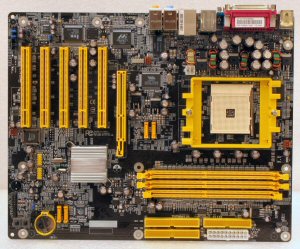
First, DFI quite insensibly saved on the chipset cooling. The low-profile aluminum heatsink installed on the nForce3 250Gb chip is working close to its limit, so you may want to replace it with something more serious before overclocking the CPU.
The second problem is that the Serial ATA ports numbered 1 and 2 are implemented through an additional PHY controller from Marvell. This controller is very capricious about high clock-gen frequencies, and Serial ATA drives attached to this controller’s ports stop to work even at a slightest overclocking. So, you should disable the first two Serial ATA ports when overclocking the DFI LANPARTY UT nF3 250Gb and use only ports 3 and 4 which are attached directly to the chipset.
The third drawback of the DFI LANPARTY UT nF3 250Gb is the strange sensitivity of the memory controller to which exactly DIMM slots the DDR SDRAM modules are plugged in. It’s better to load a pair of modules into the first and third DIMM slots at overclocking, but the use of a single memory module is the best choice. Our experiments suggest that it’s only in the latter case that you can overcome 300MHz clock-gen frequency.
Thus, the prerequisites for a serious overclocking of the Sempron 2600+ processor on the DFI LANPARTY UT nF3 250Gb mainboard are 1) put a better cooler on the chipset, 2) don’t use the first two Serial ATA channels, and 3) use a single memory stick. Keeping these points in mind we assembled the following system to overclock our Sempron 2600+:
- DFI LANPARTY UT nF3 250Gb mainboard (BIOS N32LD128.BIN);
- AVC Z7U7414001 cooler;
- 1GB Corsair CMX1024-4400C25 DDR550 SDRAM;
- PowerColor RADEON X800 XT graphics card (AGP 8x, 500MHz/500MHz);
- Western Digital Raptor WD740GD hard disk drive (Serial ATA-150).
Meeting the above-mentioned requirements, this testbed gave us no troubles as we were investigating the overclockability of the Sempron 2600+. The mainboard did its job well.
Without increasing the core voltage above the default 1.4V we managed to overclock the Sempron 2600+ to 2.28GHz. That is, the system remained stable till 285MHz clock-gen frequency. This looks already impressive, but we know that the overclockability of AMD’s 90nm cores is likely to increase at higher voltages.
The Semprons work at a lower voltage than the 1.5-volt Athlon 64. So we lifted the voltage of our Sempron 2600+ up to 1.5V and found that the processor remained stable until 302MHz clock-gen frequency. In other words, the Sempron 2600+ could work at 2.42GHz frequency at 1.5V voltage.
In order to get even higher we increased the core voltage to 1.65V. The processor reacted to that by remaining stable at 2.5GHz (313MHz clock-gen frequency). Frankly speaking, the system would start up even at higher frequencies, but was not absolutely stable: although the CPU could pass some tests, including S&M, we had problems with other applications. So, 2.5GHz frequency should be considered the highest peak we achieved.
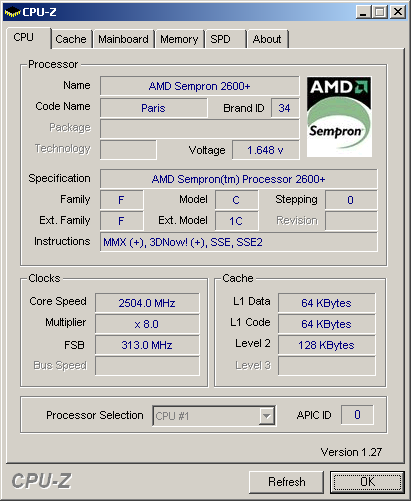
For the memory to be stable we had chosen 1:10 divisor in the BIOS Setup, which corresponded to the DDR333 option. Thus, the memory was working at 250MHz when the Sempron 2600+ was overclocked to 2.5GHz.
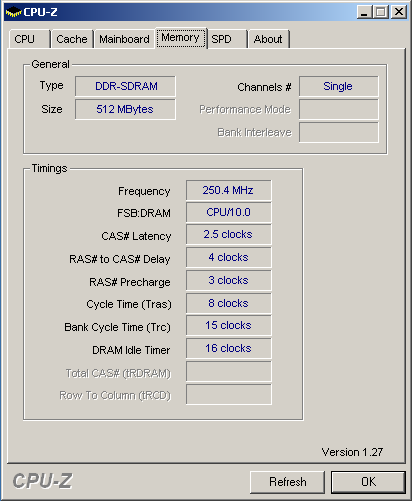
We want to emphasize the fact that the temperature of the Sempron 2600+ remained rather low even at overclocking with an increased core voltage. The maximum temperature we observed when running the CPU-burning S&M utility was 48-49В°C.
So, we managed to increase the frequency of our Sempron 2600+ by more than 50% at overclocking, which is a very satisfying result. At least many processors that permitted such a high frequency gain used to be “an overclocker’s choice” of various times
Performance of the 2600+ sempron
To make our final opinion about AMD’s new inexpensive processor for Socket 754 systems we decided to compare the Sempron 2600+ to the available alternatives. The immediate rival to the Sempron 2600+ for Socket 754 is the older Sempron 2600+ for Socket A and the symmetrical offer from Intel, the Celeron D325, of 2.53GHz frequency and a similar price.
Considering the good overclockability of the Sempron 2600+ for Socket 754, we also tested it overclocked to 2.5GHz. When thus sped up, it competes with midrange processors as well as with the overclocked Celeron D 325. We should confess at the start that our sample of the Celeron D 325 was not the best possible in terms of overclockability. It could only work normally at 3.4GHz, i.e. the FSB frequency was increased from the default 133MHz to 179MHz.
So, we used the following hardware items for our tests of the performance of the new Sempron 2600+:
- Processors:
- AMD Sempron 2600+ (Socket A, 1.83GHz, 256KB L2);
- AMD Sempron 2600+ (Socket 754, 1.6GHz, 128KB L2);
- AMD Sempron 3100+ (Socket 754, 1.8GHz, 256KB L2);
- AMD Athlon 64 2800+ (Socket 754, 1.8GHz, 512KB L2);
- AMD Athlon 64 3000+ (Socket 939, 1.8GHz, 512KB L2);
- AMD Athlon 64 3400+ (Socket 754, 2.2GHz, 1024KB L2);
- AMD Athlon 64 3500+ (Socket 939, 2.2GHz, 512KB L2);
- Intel Celeron D 325 (Socket 478, 2.53GHz, 256KB L2);
- Intel Pentium 4 2.8E (Socket 478, 2.8GHz, 1024KB L2);
- Intel Pentium 4 3.4E (Socket 478, 2.8GHz, 1024KB L2).
- Mainboards:
- ASUS P4P800-E Deluxe (Socket 478, i865PE);
- ASUS A7N8X-E Deluxe (Socket A, NVIDIA nForce2 Ultra 400);
- DFI LANPARTY UT nF3 250Gb (Socket 754, NVIDIA nForce3 250Gb);
- MSI K8N Neo2 Platinum (Socket 754, NVIDIA nForce3 250Gb).
- 2 x 512MB Corsair CMX512-3200XLPRO DDR400 SDRAM.
- PowerColor RADEON X800 XT graphics card (AGP 8x, 500MHz/500MHz).
- Western Digital Raptor WD740GD hard disk drive (Serial ATA-150).
We performed our tests in Windows XP SP2; the BIOS parameters of the mainboards were set up for the maximum performance.

The popular SuperPi benchmark has it this way: in spite of its smaller L2 cache and lower clock rate, the Sempron 2600+ for Socket 754 is slightly faster than its Socket A predecessor. The integrated memory controller is a trump of K8 architecture, and it shows its best in this test. We also see that the new Sempron 2600+ is faster than its direct competitor from Intel, the Celeron D 325, in SuperPi.
As for the speed of the overclocked Sempron 2600+, it leaves all midrange CPUs behind thanks to its rather high clock rate

The new Sempron 2600+ for Socket 754 systems performs faster in 3DMark2001 SE than its immediate rivals, the older Sempron 2600+ for Socket A and the Celeron D 325. The gap is quite wide, by the way, amounting to 13% between the new and old Sempron 2600+. A similar gap is between the Sempron 2600+ for Socket 754 and the Celeron D 325.
The performance of the overclocked Sempron 2600+ is again highly satisfying: at 2.5GHz clock rate, this CPU leaves all midrange processors from Intel behind and is a little slower than the full-featured Athlon 64 3400+ and 3500+.

The Sempron 2600+ overclocked to 2.5GHz looks even better in the newer benchmark from Futuremark. This CPU has a higher 3DMark05 CPU score than the Athlon 64 3500+ as well as the Pentium 4 3.4E! It also has a second best basic score (after the Athlon 64 3500+). This is yet another confirmation of the fact that a well-overclocked Sempron 2600+ for Socket 754 can challenge any midrange CPU.
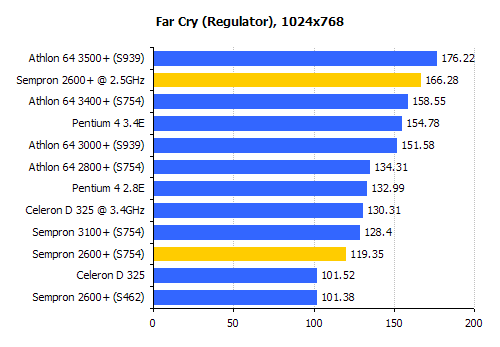

The gaming benchmarks agree that K8 architecture suits well for games, and the Sempron 2600+ for Socket 754 outperforms the Sempron 2600+ for Socket A as well as the Celeron D 325 here.
The performance of the overclocked Sempron 2600+ is higher, of course, but the reduced L2 cache and the single-channel memory controller affect negatively its speed in games. That’s why the Sempron 2600+ overclocked to 2.5GHz is slower than the Athlon 64 3500+ that works at only 2.2GHz in games.
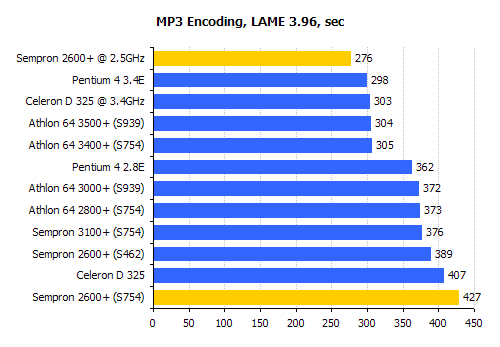
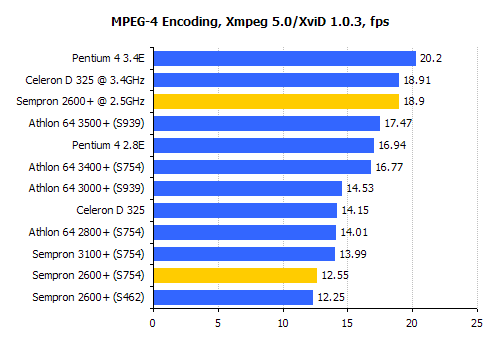
The results of our media encoding test are different. First, the Celeron D 325 is faster in such tasks than the Sempron 2600+ for Socket 754. Second, the numbers suggest that the Lame and MainConcept codecs are very sensitive to the CPU clock rate, so the older Socket A Sempron 2600+ (at 1.83GHz clock rate) finds itself ahead of the new Sempron 2600+ (1.6GHz clock rate).
When overclocked to 2.5GHz, the Sempron 2600+ easily leaves behind all midrange Athlon 64 CPUs that are clocked at 2.2GHz and lower. Intel’s NetBurst architecture is better suited for processing streaming data, so the overclocked Sempron 2600+ is almost everywhere slower than the Pentium 4 3.4E and sometimes slower than the Celeron D 325 overclocked to 3.4GHz.
Conclusion of our review
The transition of the Sempron CPU family to the Socket 754 platform is a sensible move from AMD. Trying to unify its platforms, AMD also acts for the users’ good. The advantages of the new Sempron models are obvious. We have made sure in our tests that the new Semprons for Socket 754 deliver more performance across a majority of applications than their Socket A predecessors, while their price is no higher than that of their Socket A counterparts. Moreover, low-end Socket 754 platforms can be easily upgraded by installing midrange processors from the Athlon 64 family.
AMD’s new solution also looks preferable to the Celeron D family, the competing inexpensive processors from Intel. The Semprons are generally faster in a majority of applications than Celeron D models of the same price.
Another appealing aspect of junior Sempron for Socket 754 models is their excellent overclockability. Our tests show that Semprons on the new 90nm Palermo core can add up about half their frequency at overclocking, to clock rates about 2.5GHz. For example, we managed to give our Sempron 2600+ a 56% frequency boost and the performance of the system subsequently grew by 35% in average and became comparable to that of systems with Pentium 4 3.4E and Athlon 64 3500+ processors. In other words, overclocking helps to increase the speed of the platform with an inexpensive Sempron for Socket 754 processor to the level of midrange computer systems.
The last and probably the most important thing you can deduce from this review is that the lifecycle of the Socket A platform is approaching its end. This platform has lost almost all of its appealing features, and the new Semprons make it possible to build inexpensive systems on the Socket 754 platform. The manufacture of Socket A processors will soon be halted, too. So, if you’re intending to buy an inexpensive computer, you can strike out Socket A from your options list.
![]()
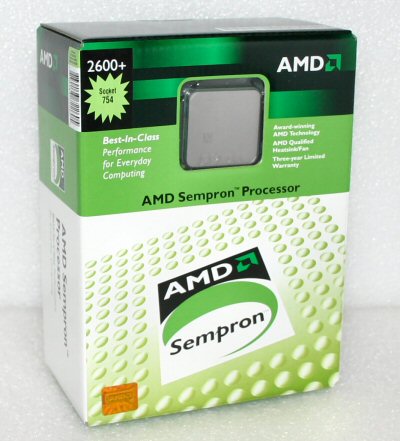
![]()




 geforce 8800gtx and 8800gts
geforce 8800gtx and 8800gts  Xtreview software download Section
Xtreview software download Section  AMD TURION 64 X2 REVIEW
AMD TURION 64 X2 REVIEW  INTEL PENTIUM D 920 , INTEL PENTIUM D 930
INTEL PENTIUM D 920 , INTEL PENTIUM D 930  6800XT REVIEW
6800XT REVIEW  computer hardware REVIEW
computer hardware REVIEW  INTEL CONROE CORE DUO 2 REVIEW VS AMD AM2
INTEL CONROE CORE DUO 2 REVIEW VS AMD AM2  INTEL PENTIUM D 805 INTEL D805
INTEL PENTIUM D 805 INTEL D805  Free desktop wallpaper
Free desktop wallpaper  online fighting game
online fighting game  Xtreview price comparison center
Xtreview price comparison center 


























